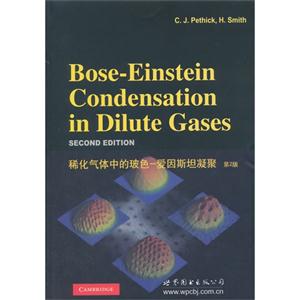-
>
宇宙、量子和人类心灵
-
>
考研数学专题练1200题
-
>
希格斯:“上帝粒子”的发明与发现
-
>
神农架叠层石:10多亿年前远古海洋微生物建造的大堡礁
-
>
二十四史天文志校注(上中下)
-
>
声音简史
-
>
浪漫地理学:追寻崇高景观
稀化气体中的玻色-爱因斯坦凝聚-第2版 版权信息
- ISBN:9787510078576
- 条形码:9787510078576 ; 978-7-5100-7857-6
- 装帧:一般胶版纸
- 册数:暂无
- 重量:暂无
- 所属分类:>>
稀化气体中的玻色-爱因斯坦凝聚-第2版 本书特色
《稀化气体中的玻色:爱因斯坦凝聚(第2版)》是一部关于稀化气体中玻色—爱因斯坦凝聚的专著。早在1925年爱因斯坦便预言,气态粒子在低温下会在各方面处于同样的量子状态。《稀化气体中的玻色:爱因斯坦凝聚(第2版)》重点论述其基础物理原理。全书共14章,每章末附有问题和参考文献,书末附有基本常数和转换因数的附录。《稀化气体中的玻色:爱因斯坦凝聚(第2版)》适用于高校物理系及相关专业的教师、研究生和从事新物态及相关研究的科研工作者。
稀化气体中的玻色-爱因斯坦凝聚-第2版 内容简介
《稀化气体中的玻色:爱因斯坦凝聚(第2版)》是一部关于稀化气体中玻色—爱因斯坦凝聚的专著。早在1925年爱因斯坦便预言,气态粒子在低温下会在各方面处于同样的量子状态。《稀化气体中的玻色:爱因斯坦凝聚(第2版)》重点论述其基础物理原理。全书共14章,每章末附有问题和参考文献,书末附有基本常数和转换因数的附录。《稀化气体中的玻色:爱因斯坦凝聚(第2版)》适用于高校物理系及相关专业的教师、研究生和从事新物态及相关研究的科研工作者。
稀化气体中的玻色-爱因斯坦凝聚-第2版 目录
1 introduction
1.1 bose—einstein condensation in atomic clouds
1.2 superfluid 4he
1.3 other condensates
1.4 overview
problems
references
2 the non—interacting bose gas
2.1 the bose distribution
2.1.1 density of states
2.2 transition temperature and condensate fraction
2.2.1 condensate fraction
2.3 density profile and velocity distribution
2.3.1 the semi—classical distribution
2.4 thermodynamic quantities
2.4.1 condensed phase
2.4.2 normal phase
2.4.3 specific heat close to tc
2.5 effect of finite particle number
problems
references
3 atomic properties
3.1 atomic structure
3.2 the zeeman effect
3.3 response to an electric field
3.4 energy scales
problems
references
4 trapping and cooling of atoms
4.1 magnetic traps
4.1.1 the quadrupole trap
4.1.2 the top trap
4.1.3 magnetic bottles and the ioffe—pritchard trap
4.1.4 microtraps
4.2 influence of laser light on an atom
4.2.1 forces on an atom in a laser field
4.2.2 optical traps
4.3 laser cooling: the doppler process
4.4 the magneto—optical trap
4.5 sisyphus cooling
4.6 evaporative cooling
4.7 spin—polarized hydrogen
problems
references
5 interactions between atoms
5.1 interatomic potentials and the van der waals interaction
5.2 basic scattering theory
5.2.1 effective interactions and the scattering length
5.3 scattering length for a model potential
5.4 scattering between different internal states
5.4.1 inelastic processes
5.4.2 elastic scattering and feshbach resonances
5.5 determination of scattering lengths
5.5.1 scattering lengths for alkali atoms and hydrogen
problems
references
6 theory of the condensed state
6.1 the gross—pitaevskii equation
6.2 the ground state for trapped bosons
6.2.1 a variational calculation
6.2.2 the thomas—fermi approximation
6.3 surface structure of clouds
6.4 healing of the condensate wave function
6.5 condensates with dipolar interactions
problems
references
7 dynamics of the condensate
7.1 general formulation
7.1.1 the hydrodynamic equations
7.2 elementary excitations
7.3 collective modes in traps
7.3.1 traps with spherical symmetry
7.3.2 anisotropic traps
7.3.3 collective coordinates and the variational method
7.4 surface modes
7.5 free expansion of the condensate
7.6 solitons
7.6.1 dark solitons
7.6.2 bright solitons
problems
references
8 microscopic theory of the bose gas
8.1 the uniform bose gas
8.1.1 the bogoliubov transformation
8.1.2 elementary excitations
8.1.3 depletion of the condensate
8.1.4 ground—state energy
8.1.5 states with definite particle number
8.2 excitations in a trapped gas
8.3 non—zero temperature
8.3.1 the hartree—fock approximation
8.3.2 the popov approximation
8.3.3 excitations in non—uniform gases
8.3.4 the semi—classical approximation
problems
references
9 rotating condensates
9.1 potential flow and quantized circulation
9.2 structure of a single vortex
9.2.1 a vortex in a uniform medium
9.2.2 vortices with multiple quanta of circulation
9.2.3 a vortex in a trapped cloud
9.2.4 an off—axis vortex
9.3 equilibrium of rotating condensates
9.3.1 traps with an axis of symmetry
9.3.2 rotating traps
9.3.3 vortex arrays
9.4 experiments on vortices
9.5 rapidly rotating condensates
9.6 collective modes in a vortex lattice
problems
references
10 superfluidity
10.1 the landau criterion
10.2 the two—component picture
10.2.1 momentum carried by excitations
10.2.2 normal fluid density
10.3 dynamical processes
10.4 first and second sound
10.5 interactions between excitations
10.5.1 landau damping
problems
references
11 trapped clouds at non—zero temperature
11.1 equilibrium properties
11.1.1 energy scales
11.1.2 transition temperature
11.1.3 thermodynamic properties
11.2 collective modes
11.2.1 hydrodynamic modes above tc
11.3 collisional relaxation above tc
11.3.1 relaxation of temperature anisotropies
11.3.2 damping of oscillations
problems
references
12 mixtures and spinor condensates
12.1 mixtures
12.1.1 equilibrium properties
12.1.2 collective modes
12.2 spinor condensates
12.2.1 mean—field description
12.2.2 beyond the mean—field approximation
problems
references
13 interference and correlations
13.1 tunnelling between two wells
13.1.1 quantum fluctuations
13.1.2 squeezed states
13.2 interference of two condensates
13.2.1 phase—locked sources
13.2.2 clouds with definite particle number
13.3 density correlations in bose gases
13.3.1 collisional shifts of spectral lines
13.4 coherent matter wave optics
13.5 criteria for bose—einstein condensation
13.5.1 the density matrix
13.5.2 fragmented condensates
problems
references
14 optical lattices
14.1 generation of optical lattices
14.1.1 one—dimensional lattices
14.1.2 higher—dimensional lattices
14.1.3 energy scales
14.2 energy bands
14.2.1 band structure for a single particle
14.2.2 band structure for interacting particles
14.2.3 tight—binding model
14.3 stability
14.3.1 hydrodynamic analysis
14.4 intrinsic non—linear effects
14.4.1 loops
14.4.2 spatial period doubling
14.5 from superfluid to insulator
14.5.1 mean—field approximation
14.5.2 effect of trapping potential
14.5.3 experimental detection of coherence
problems
references
15 lower dimensions
15.1 non—interacting gases
15.2 phase fluctuations
15.2.1 vortices and the berezinskii—kosterlitz—thouless transition
15.3 microscopic theory of phase fluctuations
15.3.1 uniform systems
15.3.2 anisotropic traps
15.4 the one—dimensional bose gas
15.4.1 the strong—coupling limit
15.4.2 arbitrary coupling
15.4.3 correlation functions
problems
references
16 fermions
16.1 equilibrium properties
16.2 effects of interactions
16.3 superfluidity
16.3.1 transition temperature
16.3.2 induced interactions
16.3.3 the condensed phase
16.4 pairing with unequal populations
16.5 boson—fermion mixtures
16.5.1 induced interactions in mixtures
problems
references
17 from atoms to molecules
17.1 bose—einstein condensation of molecules
17.2 diatomic molecules
17.2.1 binding energy and the atom—atom scattering length
17.2.2 a simple two—channel model
17.2.3 atom—atom scattering
17.3 crossover: from bcs to bec
17.3.1 wide and narrow feshbach resonances
17.3.2 the bcs wave function
17.3.3 crossover at zero temperature
17.3.4 condensate fraction and pair wave function
17.4 crossover at non—zero temperature
17.4.1 thermal molecules
17.4.2 pair fluctuations and thermal molecules
17.4.3 density of atoms
17.4.4 transition temperature
17.5 a universal limit
17.6 experiments in the crossover region
17.6.1 collective modes
17.6.2 vortices
problems
references
appendix.fundamental constants and conversion factors
inder
稀化气体中的玻色-爱因斯坦凝聚-第2版 作者简介
C. J. Pethick, H. smith是国际知名学者,在数学和物理学界享有盛誉。本书凝聚了作者多年科研和教学成果,适用于科研工作者、高校教师和研究生。
- >
中国人在乌苏里边疆区:历史与人类学概述
中国人在乌苏里边疆区:历史与人类学概述
¥20.6¥48.0 - >
新文学天穹两巨星--鲁迅与胡适/红烛学术丛书(红烛学术丛书)
新文学天穹两巨星--鲁迅与胡适/红烛学术丛书(红烛学术丛书)
¥9.9¥23.0 - >
巴金-再思录
巴金-再思录
¥19.8¥46.0 - >
山海经
山海经
¥20.4¥68.0 - >
人文阅读与收藏·良友文学丛书:一天的工作
人文阅读与收藏·良友文学丛书:一天的工作
¥19.7¥45.8 - >
上帝之肋:男人的真实旅程
上帝之肋:男人的真实旅程
¥19.3¥35.0 - >
烟与镜
烟与镜
¥15.8¥48.0 - >
唐代进士录
唐代进士录
¥20.7¥39.8
-
4.23文创礼盒A款--“作家言我精神状态”
¥42.3¥206 -
4.23文创礼盒B款--“作家言我精神状态”
¥42.3¥206 -
一句顶一万句 (印签版)
¥40.4¥68 -
百年书评史散论
¥14.9¥38 -
1980年代:小说六记
¥52.8¥69 -
中图网经典初版本封面-“老人与海”冰箱贴
¥20¥40


















